2804NRS Nursing: Case Study Analysis of Pediatric Meningitis
VerifiedAdded on 2023/06/12
|7
|1730
|191
Case Study
AI Summary
This nursing assignment presents a case study analysis of Haemophilus meningitis in a pediatric patient. It discusses the risk factors and etiology of the disease, highlighting the role of vaccination history and age. The assignment details the signs and symptoms exhibited by the patient, linking them to the underlying pathophysiology of meningitis, including fever, neck stiffness, and seizures. Furthermore, it outlines the diagnostic tests used to confirm meningitis, such as blood tests and lumbar puncture, and describes the treatment modalities, including antibiotic therapy and corticosteroids, aimed at maintaining cerebral perfusion pressure and reducing inflammation. The analysis is supported by relevant references, providing a comprehensive understanding of the condition and its management.
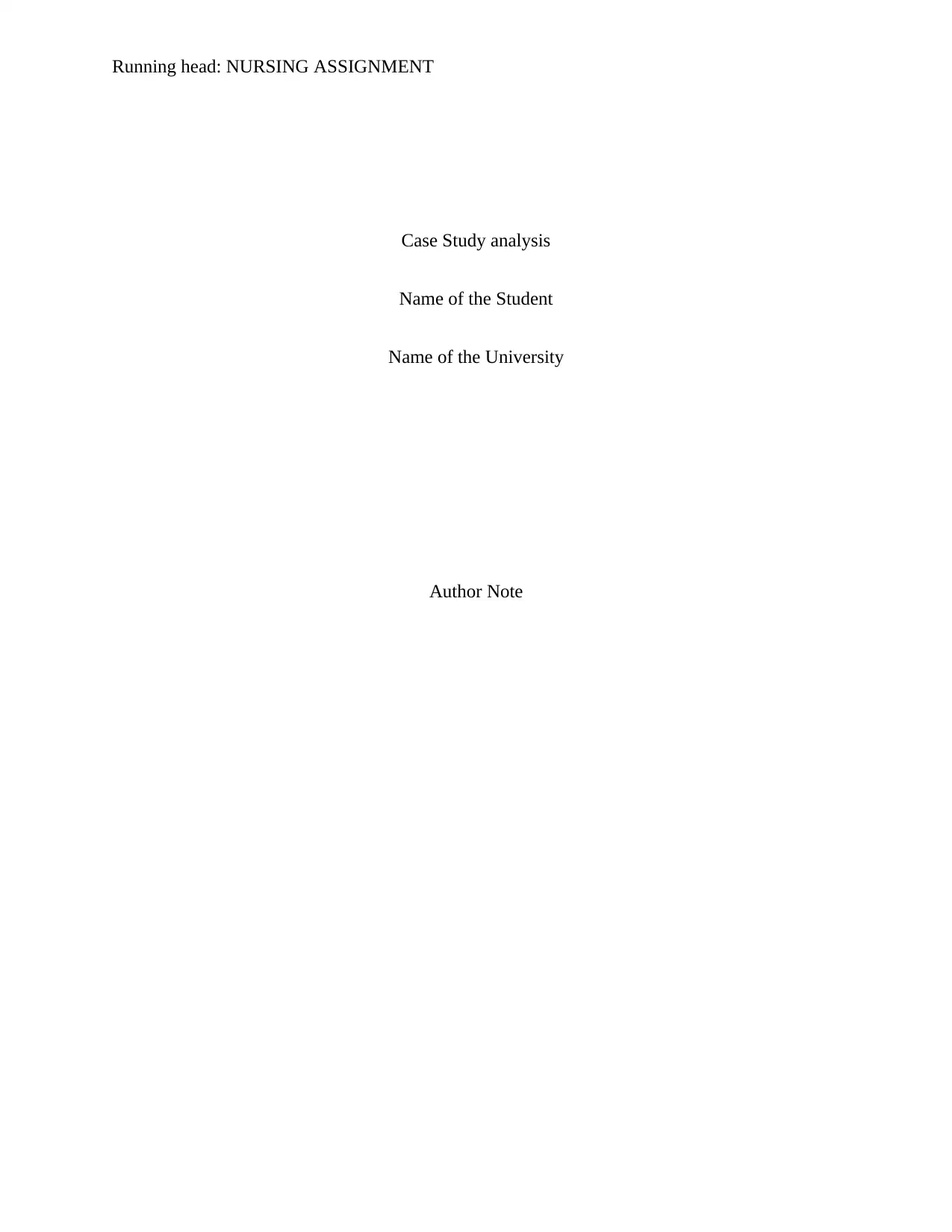
Running head: NURSING ASSIGNMENT
Case Study analysis
Name of the Student
Name of the University
Author Note
Case Study analysis
Name of the Student
Name of the University
Author Note
Paraphrase This Document
Need a fresh take? Get an instant paraphrase of this document with our AI Paraphraser
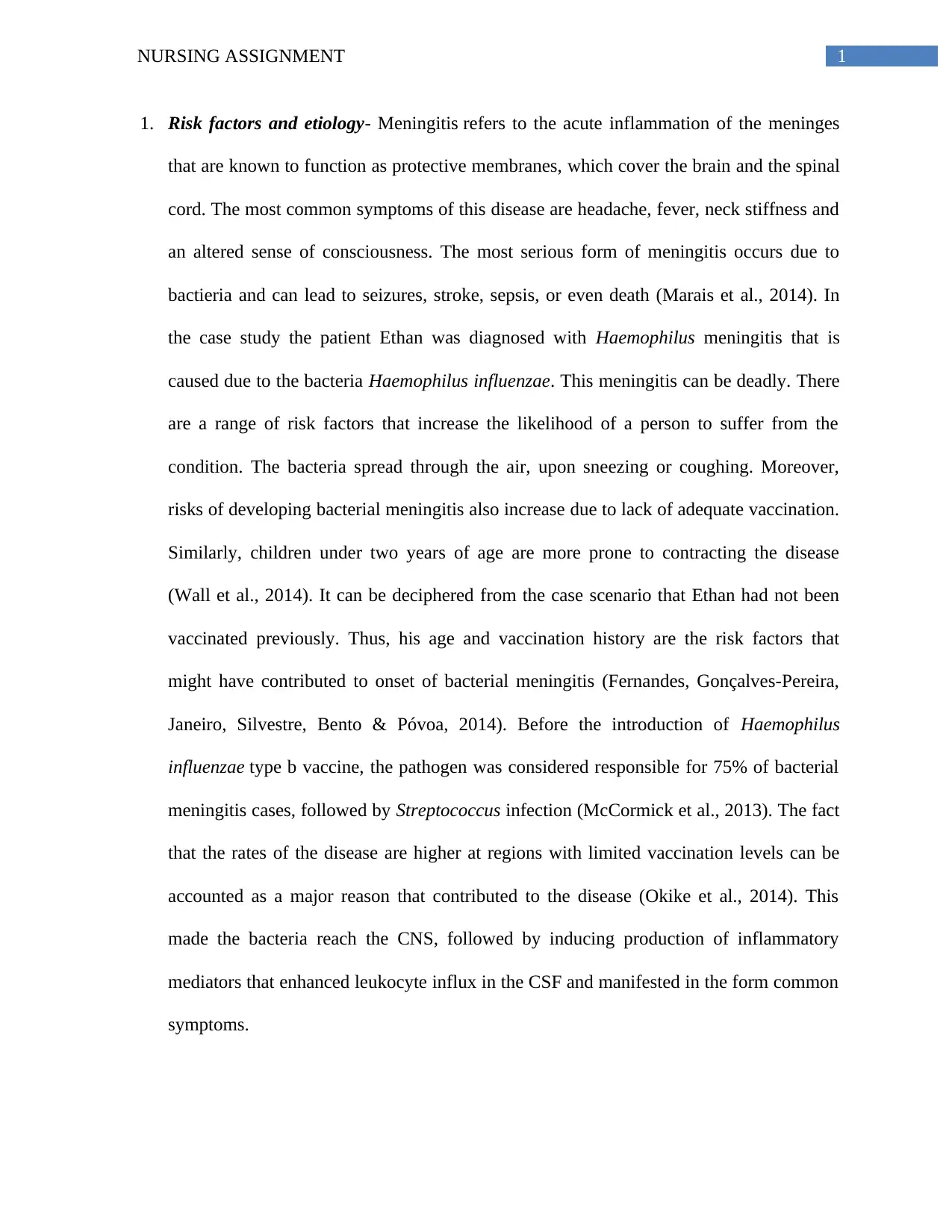
1NURSING ASSIGNMENT
1. Risk factors and etiology- Meningitis refers to the acute inflammation of the meninges
that are known to function as protective membranes, which cover the brain and the spinal
cord. The most common symptoms of this disease are headache, fever, neck stiffness and
an altered sense of consciousness. The most serious form of meningitis occurs due to
bactieria and can lead to seizures, stroke, sepsis, or even death (Marais et al., 2014). In
the case study the patient Ethan was diagnosed with Haemophilus meningitis that is
caused due to the bacteria Haemophilus influenzae. This meningitis can be deadly. There
are a range of risk factors that increase the likelihood of a person to suffer from the
condition. The bacteria spread through the air, upon sneezing or coughing. Moreover,
risks of developing bacterial meningitis also increase due to lack of adequate vaccination.
Similarly, children under two years of age are more prone to contracting the disease
(Wall et al., 2014). It can be deciphered from the case scenario that Ethan had not been
vaccinated previously. Thus, his age and vaccination history are the risk factors that
might have contributed to onset of bacterial meningitis (Fernandes, Gonçalves-Pereira,
Janeiro, Silvestre, Bento & Póvoa, 2014). Before the introduction of Haemophilus
influenzae type b vaccine, the pathogen was considered responsible for 75% of bacterial
meningitis cases, followed by Streptococcus infection (McCormick et al., 2013). The fact
that the rates of the disease are higher at regions with limited vaccination levels can be
accounted as a major reason that contributed to the disease (Okike et al., 2014). This
made the bacteria reach the CNS, followed by inducing production of inflammatory
mediators that enhanced leukocyte influx in the CSF and manifested in the form common
symptoms.
1. Risk factors and etiology- Meningitis refers to the acute inflammation of the meninges
that are known to function as protective membranes, which cover the brain and the spinal
cord. The most common symptoms of this disease are headache, fever, neck stiffness and
an altered sense of consciousness. The most serious form of meningitis occurs due to
bactieria and can lead to seizures, stroke, sepsis, or even death (Marais et al., 2014). In
the case study the patient Ethan was diagnosed with Haemophilus meningitis that is
caused due to the bacteria Haemophilus influenzae. This meningitis can be deadly. There
are a range of risk factors that increase the likelihood of a person to suffer from the
condition. The bacteria spread through the air, upon sneezing or coughing. Moreover,
risks of developing bacterial meningitis also increase due to lack of adequate vaccination.
Similarly, children under two years of age are more prone to contracting the disease
(Wall et al., 2014). It can be deciphered from the case scenario that Ethan had not been
vaccinated previously. Thus, his age and vaccination history are the risk factors that
might have contributed to onset of bacterial meningitis (Fernandes, Gonçalves-Pereira,
Janeiro, Silvestre, Bento & Póvoa, 2014). Before the introduction of Haemophilus
influenzae type b vaccine, the pathogen was considered responsible for 75% of bacterial
meningitis cases, followed by Streptococcus infection (McCormick et al., 2013). The fact
that the rates of the disease are higher at regions with limited vaccination levels can be
accounted as a major reason that contributed to the disease (Okike et al., 2014). This
made the bacteria reach the CNS, followed by inducing production of inflammatory
mediators that enhanced leukocyte influx in the CSF and manifested in the form common
symptoms.
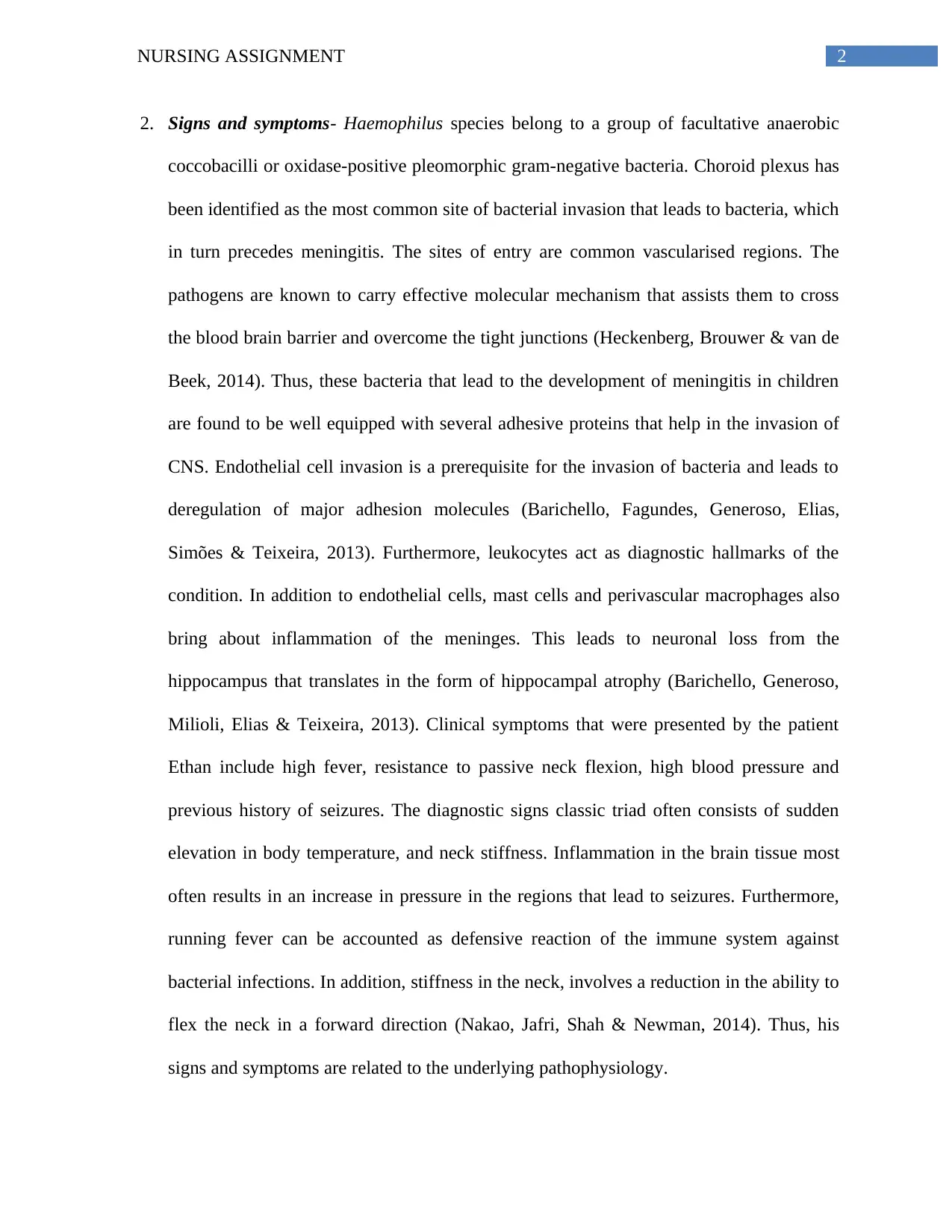
2NURSING ASSIGNMENT
2. Signs and symptoms- Haemophilus species belong to a group of facultative anaerobic
coccobacilli or oxidase-positive pleomorphic gram-negative bacteria. Choroid plexus has
been identified as the most common site of bacterial invasion that leads to bacteria, which
in turn precedes meningitis. The sites of entry are common vascularised regions. The
pathogens are known to carry effective molecular mechanism that assists them to cross
the blood brain barrier and overcome the tight junctions (Heckenberg, Brouwer & van de
Beek, 2014). Thus, these bacteria that lead to the development of meningitis in children
are found to be well equipped with several adhesive proteins that help in the invasion of
CNS. Endothelial cell invasion is a prerequisite for the invasion of bacteria and leads to
deregulation of major adhesion molecules (Barichello, Fagundes, Generoso, Elias,
Simões & Teixeira, 2013). Furthermore, leukocytes act as diagnostic hallmarks of the
condition. In addition to endothelial cells, mast cells and perivascular macrophages also
bring about inflammation of the meninges. This leads to neuronal loss from the
hippocampus that translates in the form of hippocampal atrophy (Barichello, Generoso,
Milioli, Elias & Teixeira, 2013). Clinical symptoms that were presented by the patient
Ethan include high fever, resistance to passive neck flexion, high blood pressure and
previous history of seizures. The diagnostic signs classic triad often consists of sudden
elevation in body temperature, and neck stiffness. Inflammation in the brain tissue most
often results in an increase in pressure in the regions that lead to seizures. Furthermore,
running fever can be accounted as defensive reaction of the immune system against
bacterial infections. In addition, stiffness in the neck, involves a reduction in the ability to
flex the neck in a forward direction (Nakao, Jafri, Shah & Newman, 2014). Thus, his
signs and symptoms are related to the underlying pathophysiology.
2. Signs and symptoms- Haemophilus species belong to a group of facultative anaerobic
coccobacilli or oxidase-positive pleomorphic gram-negative bacteria. Choroid plexus has
been identified as the most common site of bacterial invasion that leads to bacteria, which
in turn precedes meningitis. The sites of entry are common vascularised regions. The
pathogens are known to carry effective molecular mechanism that assists them to cross
the blood brain barrier and overcome the tight junctions (Heckenberg, Brouwer & van de
Beek, 2014). Thus, these bacteria that lead to the development of meningitis in children
are found to be well equipped with several adhesive proteins that help in the invasion of
CNS. Endothelial cell invasion is a prerequisite for the invasion of bacteria and leads to
deregulation of major adhesion molecules (Barichello, Fagundes, Generoso, Elias,
Simões & Teixeira, 2013). Furthermore, leukocytes act as diagnostic hallmarks of the
condition. In addition to endothelial cells, mast cells and perivascular macrophages also
bring about inflammation of the meninges. This leads to neuronal loss from the
hippocampus that translates in the form of hippocampal atrophy (Barichello, Generoso,
Milioli, Elias & Teixeira, 2013). Clinical symptoms that were presented by the patient
Ethan include high fever, resistance to passive neck flexion, high blood pressure and
previous history of seizures. The diagnostic signs classic triad often consists of sudden
elevation in body temperature, and neck stiffness. Inflammation in the brain tissue most
often results in an increase in pressure in the regions that lead to seizures. Furthermore,
running fever can be accounted as defensive reaction of the immune system against
bacterial infections. In addition, stiffness in the neck, involves a reduction in the ability to
flex the neck in a forward direction (Nakao, Jafri, Shah & Newman, 2014). Thus, his
signs and symptoms are related to the underlying pathophysiology.
⊘ This is a preview!⊘
Do you want full access?
Subscribe today to unlock all pages.

Trusted by 1+ million students worldwide
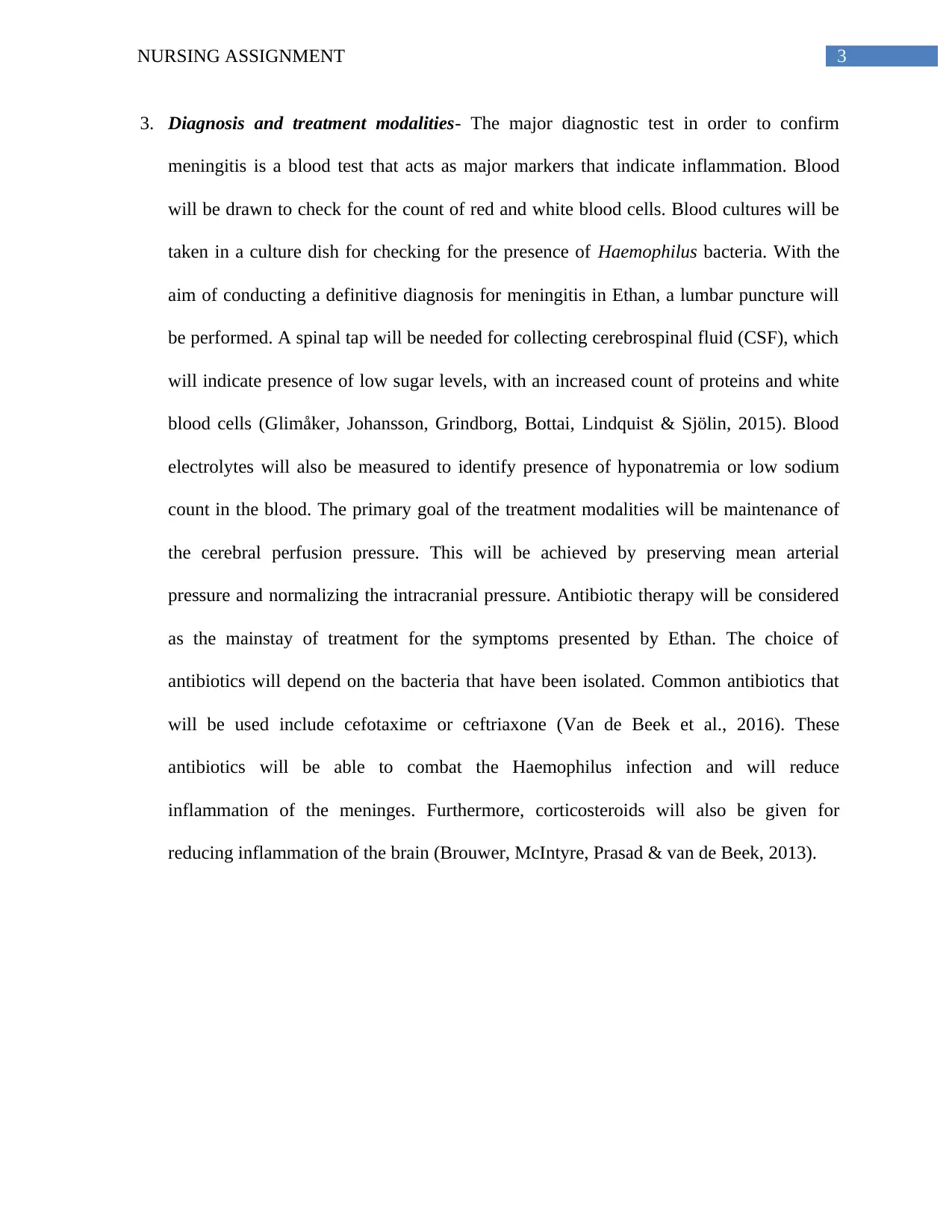
3NURSING ASSIGNMENT
3. Diagnosis and treatment modalities- The major diagnostic test in order to confirm
meningitis is a blood test that acts as major markers that indicate inflammation. Blood
will be drawn to check for the count of red and white blood cells. Blood cultures will be
taken in a culture dish for checking for the presence of Haemophilus bacteria. With the
aim of conducting a definitive diagnosis for meningitis in Ethan, a lumbar puncture will
be performed. A spinal tap will be needed for collecting cerebrospinal fluid (CSF), which
will indicate presence of low sugar levels, with an increased count of proteins and white
blood cells (Glimåker, Johansson, Grindborg, Bottai, Lindquist & Sjölin, 2015). Blood
electrolytes will also be measured to identify presence of hyponatremia or low sodium
count in the blood. The primary goal of the treatment modalities will be maintenance of
the cerebral perfusion pressure. This will be achieved by preserving mean arterial
pressure and normalizing the intracranial pressure. Antibiotic therapy will be considered
as the mainstay of treatment for the symptoms presented by Ethan. The choice of
antibiotics will depend on the bacteria that have been isolated. Common antibiotics that
will be used include cefotaxime or ceftriaxone (Van de Beek et al., 2016). These
antibiotics will be able to combat the Haemophilus infection and will reduce
inflammation of the meninges. Furthermore, corticosteroids will also be given for
reducing inflammation of the brain (Brouwer, McIntyre, Prasad & van de Beek, 2013).
3. Diagnosis and treatment modalities- The major diagnostic test in order to confirm
meningitis is a blood test that acts as major markers that indicate inflammation. Blood
will be drawn to check for the count of red and white blood cells. Blood cultures will be
taken in a culture dish for checking for the presence of Haemophilus bacteria. With the
aim of conducting a definitive diagnosis for meningitis in Ethan, a lumbar puncture will
be performed. A spinal tap will be needed for collecting cerebrospinal fluid (CSF), which
will indicate presence of low sugar levels, with an increased count of proteins and white
blood cells (Glimåker, Johansson, Grindborg, Bottai, Lindquist & Sjölin, 2015). Blood
electrolytes will also be measured to identify presence of hyponatremia or low sodium
count in the blood. The primary goal of the treatment modalities will be maintenance of
the cerebral perfusion pressure. This will be achieved by preserving mean arterial
pressure and normalizing the intracranial pressure. Antibiotic therapy will be considered
as the mainstay of treatment for the symptoms presented by Ethan. The choice of
antibiotics will depend on the bacteria that have been isolated. Common antibiotics that
will be used include cefotaxime or ceftriaxone (Van de Beek et al., 2016). These
antibiotics will be able to combat the Haemophilus infection and will reduce
inflammation of the meninges. Furthermore, corticosteroids will also be given for
reducing inflammation of the brain (Brouwer, McIntyre, Prasad & van de Beek, 2013).
Paraphrase This Document
Need a fresh take? Get an instant paraphrase of this document with our AI Paraphraser
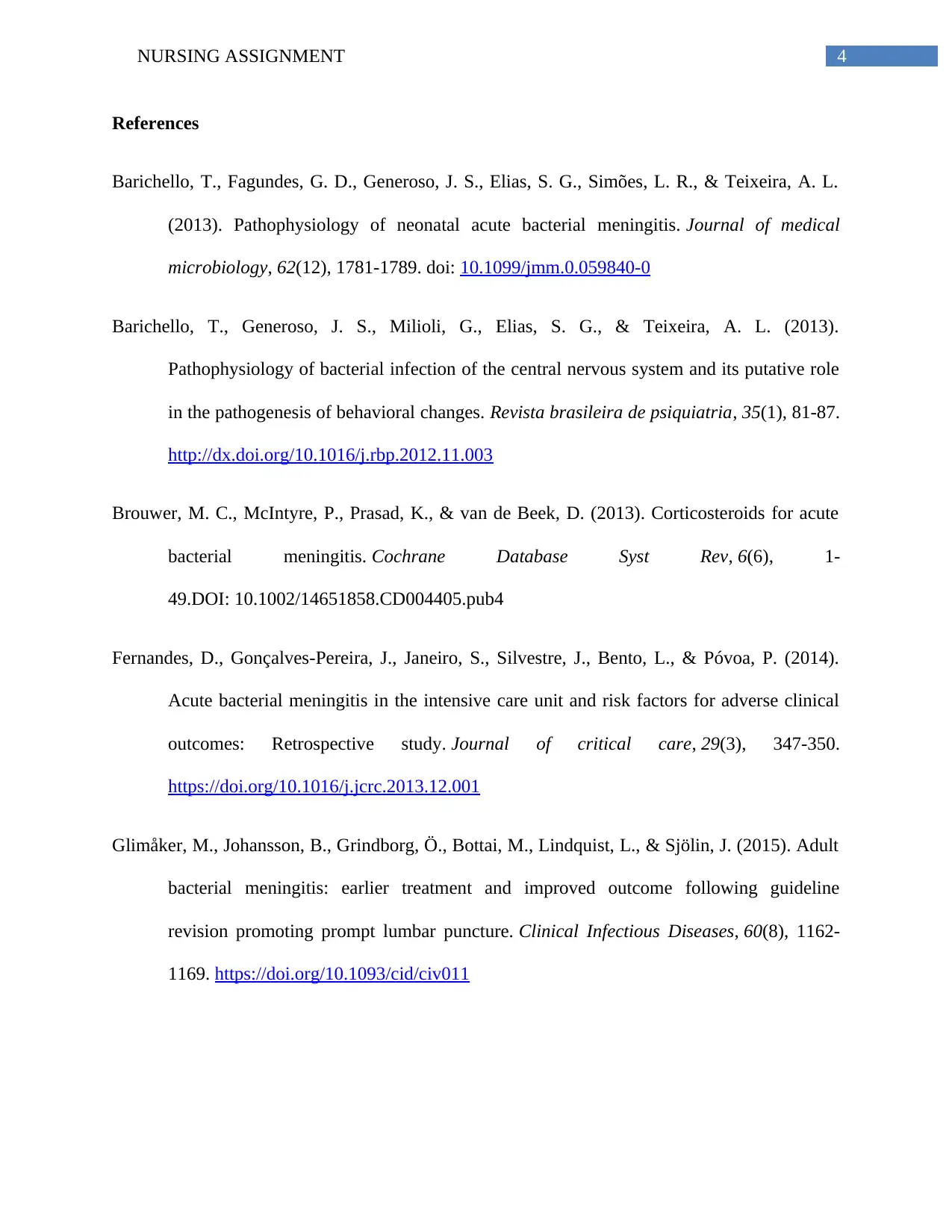
4NURSING ASSIGNMENT
References
Barichello, T., Fagundes, G. D., Generoso, J. S., Elias, S. G., Simões, L. R., & Teixeira, A. L.
(2013). Pathophysiology of neonatal acute bacterial meningitis. Journal of medical
microbiology, 62(12), 1781-1789. doi: 10.1099/jmm.0.059840-0
Barichello, T., Generoso, J. S., Milioli, G., Elias, S. G., & Teixeira, A. L. (2013).
Pathophysiology of bacterial infection of the central nervous system and its putative role
in the pathogenesis of behavioral changes. Revista brasileira de psiquiatria, 35(1), 81-87.
http://dx.doi.org/10.1016/j.rbp.2012.11.003
Brouwer, M. C., McIntyre, P., Prasad, K., & van de Beek, D. (2013). Corticosteroids for acute
bacterial meningitis. Cochrane Database Syst Rev, 6(6), 1-
49.DOI: 10.1002/14651858.CD004405.pub4
Fernandes, D., Gonçalves-Pereira, J., Janeiro, S., Silvestre, J., Bento, L., & Póvoa, P. (2014).
Acute bacterial meningitis in the intensive care unit and risk factors for adverse clinical
outcomes: Retrospective study. Journal of critical care, 29(3), 347-350.
https://doi.org/10.1016/j.jcrc.2013.12.001
Glimåker, M., Johansson, B., Grindborg, Ö., Bottai, M., Lindquist, L., & Sjölin, J. (2015). Adult
bacterial meningitis: earlier treatment and improved outcome following guideline
revision promoting prompt lumbar puncture. Clinical Infectious Diseases, 60(8), 1162-
1169. https://doi.org/10.1093/cid/civ011
References
Barichello, T., Fagundes, G. D., Generoso, J. S., Elias, S. G., Simões, L. R., & Teixeira, A. L.
(2013). Pathophysiology of neonatal acute bacterial meningitis. Journal of medical
microbiology, 62(12), 1781-1789. doi: 10.1099/jmm.0.059840-0
Barichello, T., Generoso, J. S., Milioli, G., Elias, S. G., & Teixeira, A. L. (2013).
Pathophysiology of bacterial infection of the central nervous system and its putative role
in the pathogenesis of behavioral changes. Revista brasileira de psiquiatria, 35(1), 81-87.
http://dx.doi.org/10.1016/j.rbp.2012.11.003
Brouwer, M. C., McIntyre, P., Prasad, K., & van de Beek, D. (2013). Corticosteroids for acute
bacterial meningitis. Cochrane Database Syst Rev, 6(6), 1-
49.DOI: 10.1002/14651858.CD004405.pub4
Fernandes, D., Gonçalves-Pereira, J., Janeiro, S., Silvestre, J., Bento, L., & Póvoa, P. (2014).
Acute bacterial meningitis in the intensive care unit and risk factors for adverse clinical
outcomes: Retrospective study. Journal of critical care, 29(3), 347-350.
https://doi.org/10.1016/j.jcrc.2013.12.001
Glimåker, M., Johansson, B., Grindborg, Ö., Bottai, M., Lindquist, L., & Sjölin, J. (2015). Adult
bacterial meningitis: earlier treatment and improved outcome following guideline
revision promoting prompt lumbar puncture. Clinical Infectious Diseases, 60(8), 1162-
1169. https://doi.org/10.1093/cid/civ011
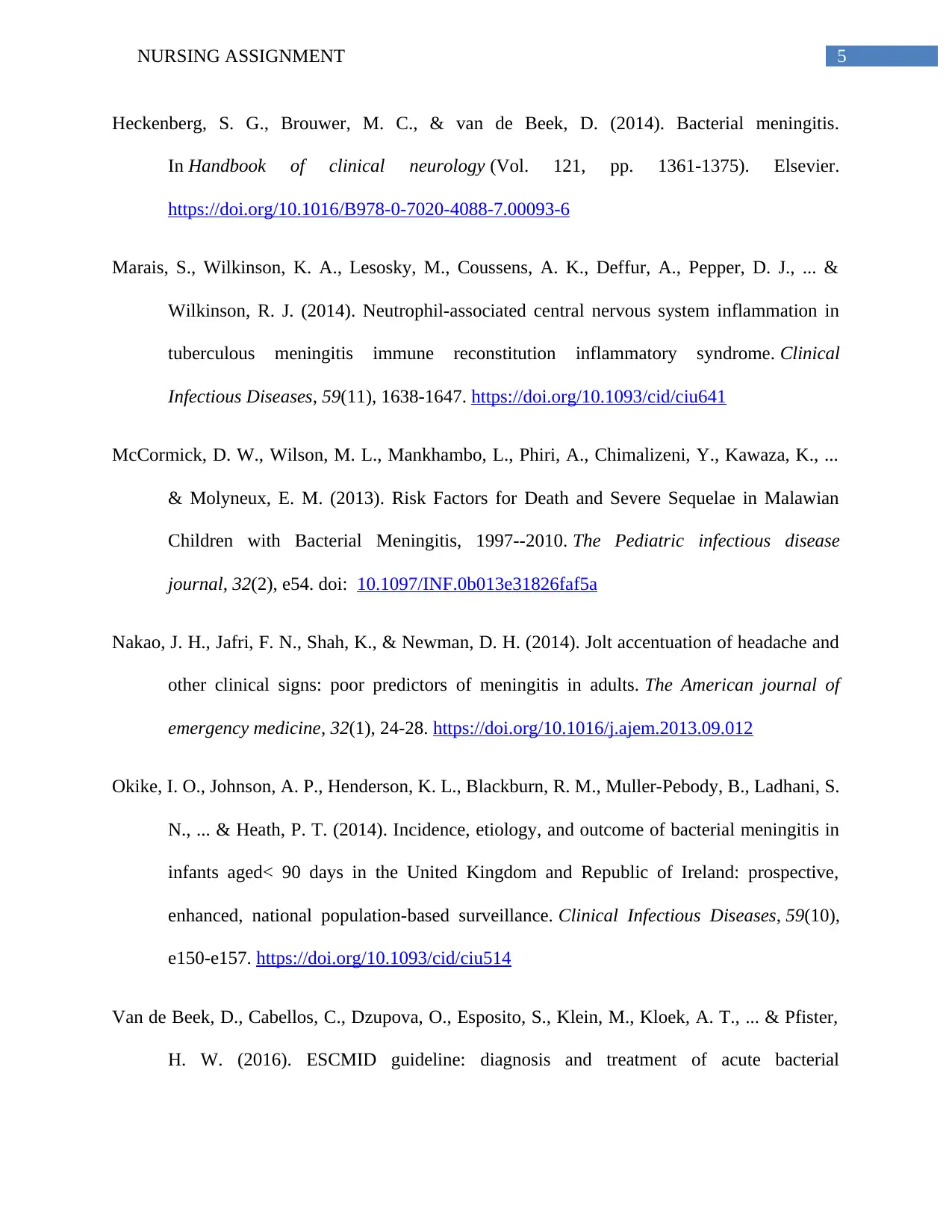
5NURSING ASSIGNMENT
Heckenberg, S. G., Brouwer, M. C., & van de Beek, D. (2014). Bacterial meningitis.
In Handbook of clinical neurology (Vol. 121, pp. 1361-1375). Elsevier.
https://doi.org/10.1016/B978-0-7020-4088-7.00093-6
Marais, S., Wilkinson, K. A., Lesosky, M., Coussens, A. K., Deffur, A., Pepper, D. J., ... &
Wilkinson, R. J. (2014). Neutrophil-associated central nervous system inflammation in
tuberculous meningitis immune reconstitution inflammatory syndrome. Clinical
Infectious Diseases, 59(11), 1638-1647. https://doi.org/10.1093/cid/ciu641
McCormick, D. W., Wilson, M. L., Mankhambo, L., Phiri, A., Chimalizeni, Y., Kawaza, K., ...
& Molyneux, E. M. (2013). Risk Factors for Death and Severe Sequelae in Malawian
Children with Bacterial Meningitis, 1997--2010. The Pediatric infectious disease
journal, 32(2), e54. doi: 10.1097/INF.0b013e31826faf5a
Nakao, J. H., Jafri, F. N., Shah, K., & Newman, D. H. (2014). Jolt accentuation of headache and
other clinical signs: poor predictors of meningitis in adults. The American journal of
emergency medicine, 32(1), 24-28. https://doi.org/10.1016/j.ajem.2013.09.012
Okike, I. O., Johnson, A. P., Henderson, K. L., Blackburn, R. M., Muller-Pebody, B., Ladhani, S.
N., ... & Heath, P. T. (2014). Incidence, etiology, and outcome of bacterial meningitis in
infants aged< 90 days in the United Kingdom and Republic of Ireland: prospective,
enhanced, national population-based surveillance. Clinical Infectious Diseases, 59(10),
e150-e157. https://doi.org/10.1093/cid/ciu514
Van de Beek, D., Cabellos, C., Dzupova, O., Esposito, S., Klein, M., Kloek, A. T., ... & Pfister,
H. W. (2016). ESCMID guideline: diagnosis and treatment of acute bacterial
Heckenberg, S. G., Brouwer, M. C., & van de Beek, D. (2014). Bacterial meningitis.
In Handbook of clinical neurology (Vol. 121, pp. 1361-1375). Elsevier.
https://doi.org/10.1016/B978-0-7020-4088-7.00093-6
Marais, S., Wilkinson, K. A., Lesosky, M., Coussens, A. K., Deffur, A., Pepper, D. J., ... &
Wilkinson, R. J. (2014). Neutrophil-associated central nervous system inflammation in
tuberculous meningitis immune reconstitution inflammatory syndrome. Clinical
Infectious Diseases, 59(11), 1638-1647. https://doi.org/10.1093/cid/ciu641
McCormick, D. W., Wilson, M. L., Mankhambo, L., Phiri, A., Chimalizeni, Y., Kawaza, K., ...
& Molyneux, E. M. (2013). Risk Factors for Death and Severe Sequelae in Malawian
Children with Bacterial Meningitis, 1997--2010. The Pediatric infectious disease
journal, 32(2), e54. doi: 10.1097/INF.0b013e31826faf5a
Nakao, J. H., Jafri, F. N., Shah, K., & Newman, D. H. (2014). Jolt accentuation of headache and
other clinical signs: poor predictors of meningitis in adults. The American journal of
emergency medicine, 32(1), 24-28. https://doi.org/10.1016/j.ajem.2013.09.012
Okike, I. O., Johnson, A. P., Henderson, K. L., Blackburn, R. M., Muller-Pebody, B., Ladhani, S.
N., ... & Heath, P. T. (2014). Incidence, etiology, and outcome of bacterial meningitis in
infants aged< 90 days in the United Kingdom and Republic of Ireland: prospective,
enhanced, national population-based surveillance. Clinical Infectious Diseases, 59(10),
e150-e157. https://doi.org/10.1093/cid/ciu514
Van de Beek, D., Cabellos, C., Dzupova, O., Esposito, S., Klein, M., Kloek, A. T., ... & Pfister,
H. W. (2016). ESCMID guideline: diagnosis and treatment of acute bacterial
⊘ This is a preview!⊘
Do you want full access?
Subscribe today to unlock all pages.

Trusted by 1+ million students worldwide
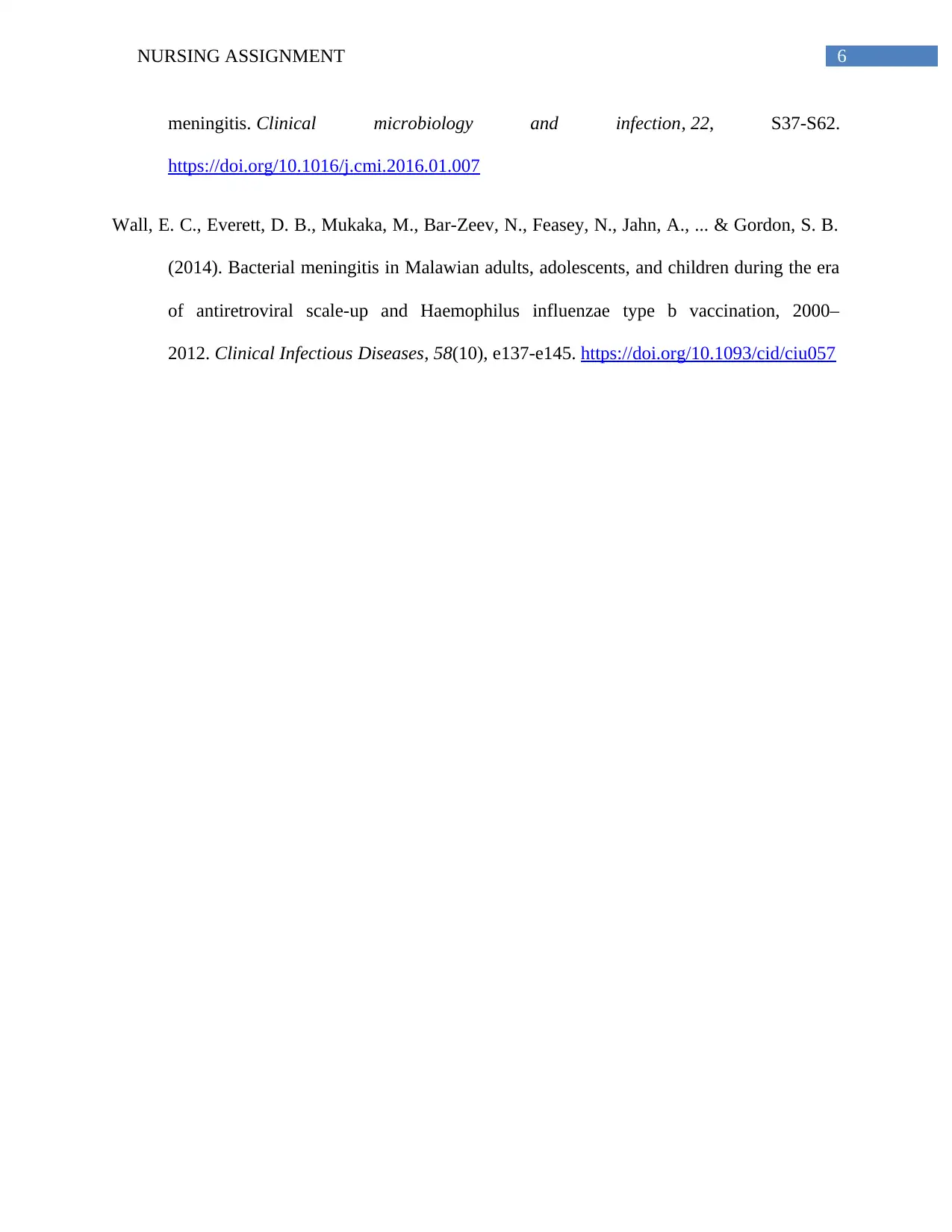
6NURSING ASSIGNMENT
meningitis. Clinical microbiology and infection, 22, S37-S62.
https://doi.org/10.1016/j.cmi.2016.01.007
Wall, E. C., Everett, D. B., Mukaka, M., Bar-Zeev, N., Feasey, N., Jahn, A., ... & Gordon, S. B.
(2014). Bacterial meningitis in Malawian adults, adolescents, and children during the era
of antiretroviral scale-up and Haemophilus influenzae type b vaccination, 2000–
2012. Clinical Infectious Diseases, 58(10), e137-e145. https://doi.org/10.1093/cid/ciu057
meningitis. Clinical microbiology and infection, 22, S37-S62.
https://doi.org/10.1016/j.cmi.2016.01.007
Wall, E. C., Everett, D. B., Mukaka, M., Bar-Zeev, N., Feasey, N., Jahn, A., ... & Gordon, S. B.
(2014). Bacterial meningitis in Malawian adults, adolescents, and children during the era
of antiretroviral scale-up and Haemophilus influenzae type b vaccination, 2000–
2012. Clinical Infectious Diseases, 58(10), e137-e145. https://doi.org/10.1093/cid/ciu057
1 out of 7
Your All-in-One AI-Powered Toolkit for Academic Success.
+13062052269
info@desklib.com
Available 24*7 on WhatsApp / Email
![[object Object]](/_next/static/media/star-bottom.7253800d.svg)
Unlock your academic potential
Copyright © 2020–2025 A2Z Services. All Rights Reserved. Developed and managed by ZUCOL.


